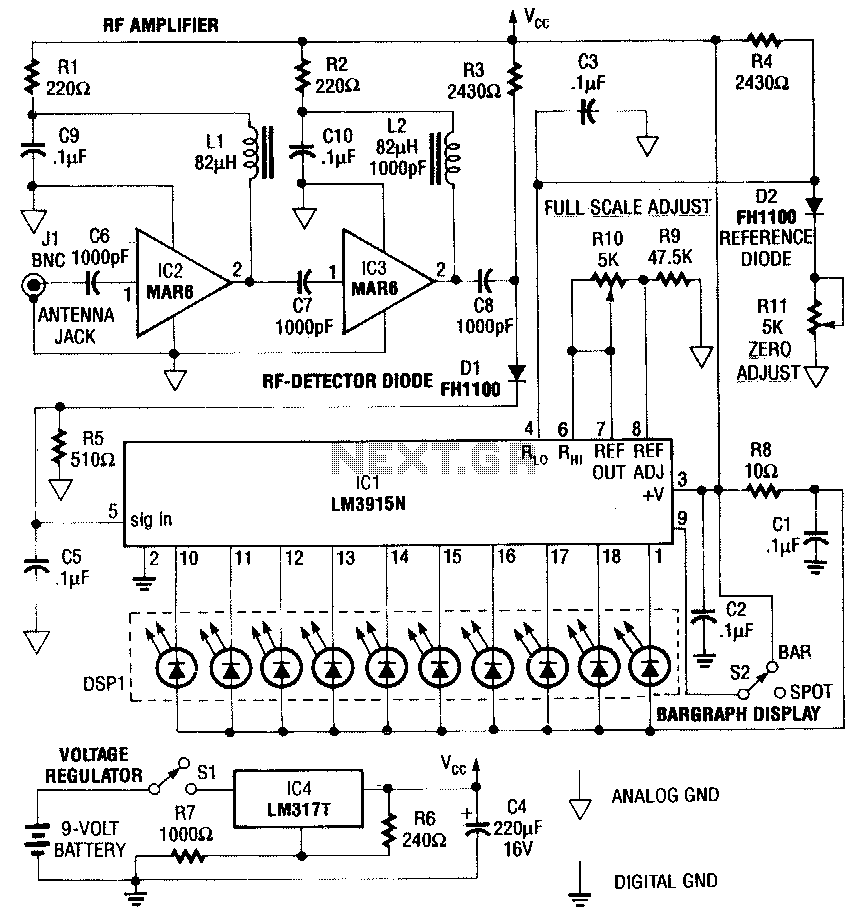
Bug-detector

This RF detector is capable of locating low-power transmitters (such as bugs) that are not visible. It can detect the presence of a 1-mW transmitter from a distance of 20 feet, making it sensitive enough to identify even the smallest bugs. As the RF detector is brought closer to the bug, an increasing number of segments on its LED bar-graph display illuminate, facilitating direction finding. The front end of the device features a two-stage wideband RF amplifier and a forward-biased hot-carrier diode serving as the detector. After detection, the signal is filtered and sent to IC1, an LM3915N bar-graph driver that provides a logarithmic output. Each successive LED segment corresponds to a 3-dB increase.
The RF detector circuit is designed to effectively locate and identify low-power RF transmitters, which are commonly used in covert surveillance applications. The core functionality relies on a two-stage wideband RF amplifier that amplifies weak incoming signals. This amplification stage is crucial for enhancing the sensitivity of the detector, allowing it to pick up signals that would otherwise be too weak to detect.
The use of a hot-carrier diode as the detection element is significant in this circuit. This type of diode is known for its ability to detect RF signals with high efficiency, making it ideal for this application. The diode converts the RF signal into a DC voltage, which is then processed further in the circuit.
The output from the hot-carrier diode is filtered to remove any unwanted noise and to ensure that only the desired signal is passed on to the LM3915N bar-graph driver. The LM3915N is a versatile integrated circuit that translates the amplitude of the incoming signal into a visual representation on the LED bar graph. The logarithmic output characteristic of the LM3915N allows for a more intuitive display of signal strength, where each segment of the LED display corresponds to a 3-dB increase in signal level. This feature is particularly useful for users as it provides a clear indication of proximity to the transmitter.
In summary, this RF detector circuit is an effective tool for locating hidden low-power transmitters, utilizing a combination of RF amplification, efficient signal detection, and a user-friendly visual output to assist in the identification of concealed devices. Its design principles and component selection make it a reliable choice for applications requiring discreet surveillance and monitoring.This rf detector can locate low-power transmitters (bugs) that are hidden from sight. It can sense the presence of a 1-mW transmitter at 20 feet. which is sensitive enough to detect the tiniest bug. As you bring the rf detector closer to the bug, more and more segments of its LED bar-graph display light, which aids in direction finding. The front end has a two-stage wideband rf amplifier, and a forward-biased hot-carrier diode for a detector.
After detection, the signal is filtered and fed to IC1, an LM3915N bar-graph driver having a logarithmic output. Each successive LED segment represents a 3-dB step. 🔗 External reference
The RF detector circuit is designed to effectively locate and identify low-power RF transmitters, which are commonly used in covert surveillance applications. The core functionality relies on a two-stage wideband RF amplifier that amplifies weak incoming signals. This amplification stage is crucial for enhancing the sensitivity of the detector, allowing it to pick up signals that would otherwise be too weak to detect.
The use of a hot-carrier diode as the detection element is significant in this circuit. This type of diode is known for its ability to detect RF signals with high efficiency, making it ideal for this application. The diode converts the RF signal into a DC voltage, which is then processed further in the circuit.
The output from the hot-carrier diode is filtered to remove any unwanted noise and to ensure that only the desired signal is passed on to the LM3915N bar-graph driver. The LM3915N is a versatile integrated circuit that translates the amplitude of the incoming signal into a visual representation on the LED bar graph. The logarithmic output characteristic of the LM3915N allows for a more intuitive display of signal strength, where each segment of the LED display corresponds to a 3-dB increase in signal level. This feature is particularly useful for users as it provides a clear indication of proximity to the transmitter.
In summary, this RF detector circuit is an effective tool for locating hidden low-power transmitters, utilizing a combination of RF amplification, efficient signal detection, and a user-friendly visual output to assist in the identification of concealed devices. Its design principles and component selection make it a reliable choice for applications requiring discreet surveillance and monitoring.This rf detector can locate low-power transmitters (bugs) that are hidden from sight. It can sense the presence of a 1-mW transmitter at 20 feet. which is sensitive enough to detect the tiniest bug. As you bring the rf detector closer to the bug, more and more segments of its LED bar-graph display light, which aids in direction finding. The front end has a two-stage wideband rf amplifier, and a forward-biased hot-carrier diode for a detector.
After detection, the signal is filtered and fed to IC1, an LM3915N bar-graph driver having a logarithmic output. Each successive LED segment represents a 3-dB step. 🔗 External reference